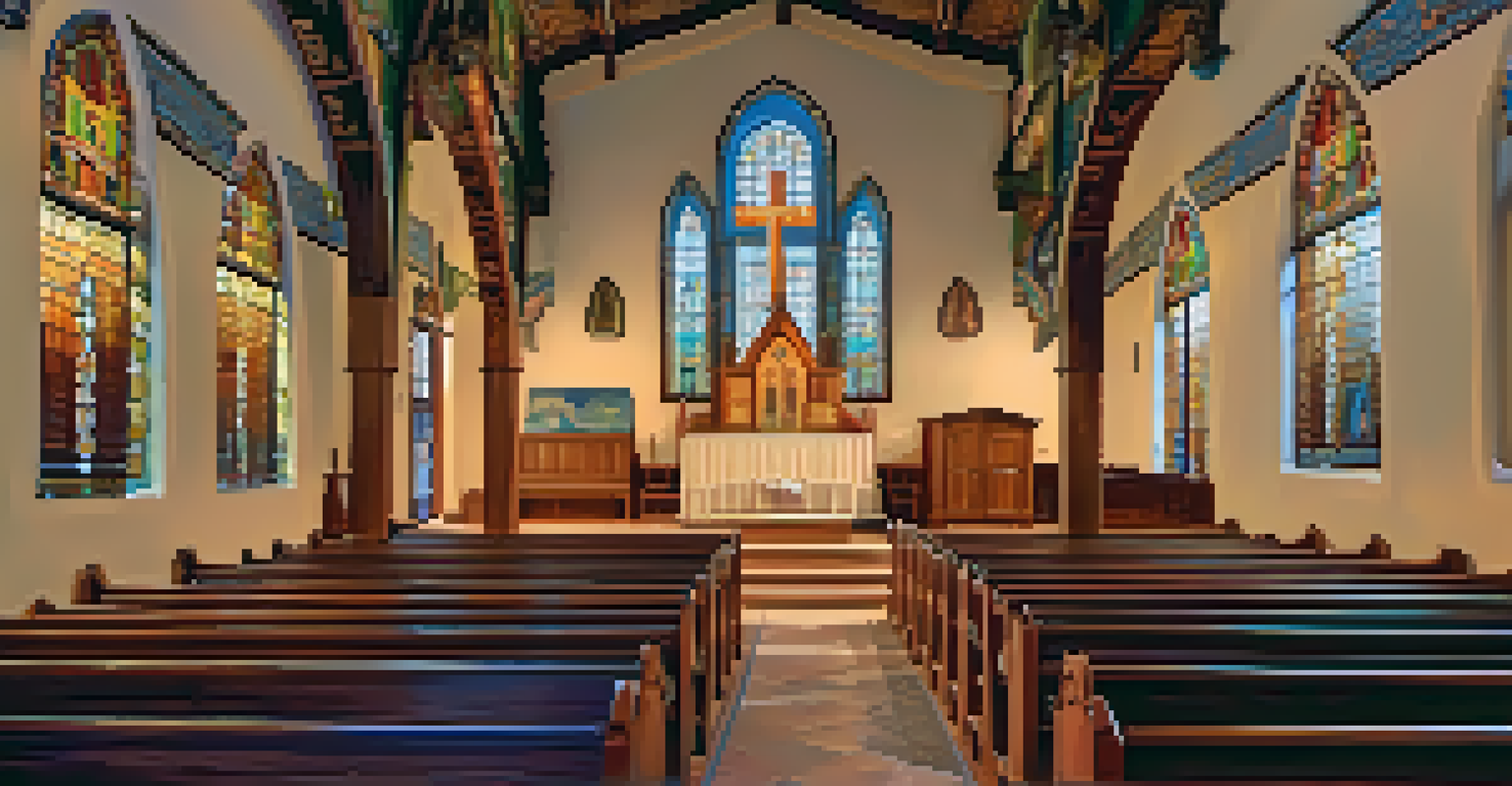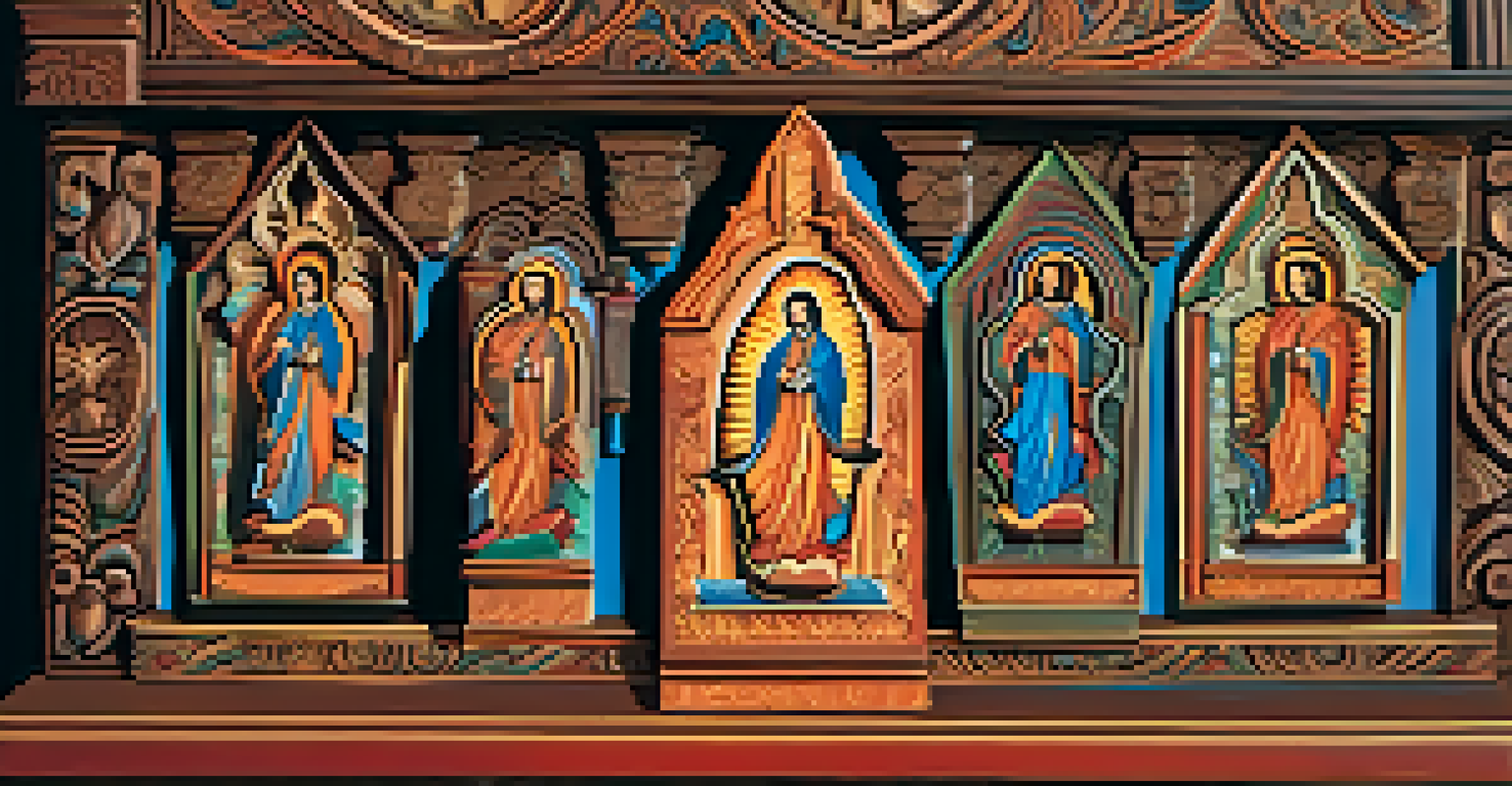The Architecture of Tucson's Historic Churches

The Origins of Tucson's Historic Churches
Tucson's historic churches are a testament to the city's rich cultural tapestry, reflecting influences from Native American, Spanish, and Mexican heritage. Many of these structures date back to the 18th and 19th centuries, showcasing the early European settlers' devotion and architectural skills. As you stroll through Tucson, the churches stand as a reminder of the city's evolution over the centuries, capturing significant social and religious milestones.
Architecture is a visual art, and the buildings speak for themselves.
One of the oldest, San Xavier del Bac, often referred to as the 'White Dove of the Desert,' was established in 1700 and showcases stunning Baroque architecture. Its intricate details and vibrant frescoes are not just aesthetic features; they tell stories of faith and community. Exploring these origins provides insights into how these churches have shaped the identity of Tucson.
Additionally, the architectural diversity found in these churches illustrates the merging of various cultural styles. This blending is especially evident in the designs, materials, and artistic expressions seen throughout the structures, making each church a unique piece of Tucson's historical narrative.
Architectural Styles: A Blend of Cultures
The architectural styles of Tucson's churches are a captivating blend of various influences, primarily Spanish Colonial, Mexican, and Native American designs. This mix creates a visually striking landscape that tells a story of cultural exchange and adaptation. For instance, the use of adobe bricks, a staple in Southwestern architecture, is prominently featured in many churches, providing both aesthetic value and practical benefits.

Moreover, the elaborate decorations, such as retablos and altarpieces, are often influenced by both Baroque and folk art traditions, showcasing the unique regional characteristics. These artistic elements not only enhance the visual appeal but also serve to engage worshippers on a spiritual level. Each church's design reflects the community's values and beliefs, making them significant beyond their physical presence.
Tucson's Churches Reflect Cultural Heritage
The historic churches of Tucson embody a rich blend of Native American, Spanish, and Mexican influences, showcasing the city's diverse cultural narrative.
Visiting these churches offers a chance to appreciate the craftsmanship and attention to detail that went into their construction. From the intricate carvings to the vibrant colors used in stained glass, each element contributes to the overall experience, inviting visitors to reflect on the harmonious blend of cultures that defines Tucson.
San Xavier del Bac: A Masterpiece of Baroque Architecture
San Xavier del Bac stands out as one of the finest examples of Spanish Colonial Baroque architecture in the United States. Known for its stunning white façade and ornate interior, this church is often referred to as the 'Mother Church of the Pima.' The structure's design features a combination of curved lines and intricate detailing, making it a visual feast for anyone who visits.
A church is a place where we can come together as a community, to share our stories and celebrate our lives.
The church was constructed in the late 18th century and has been meticulously preserved over the years. Visitors can admire its beautifully painted ceiling and the detailed carvings that adorn the altars. Each visit is a chance to witness the artistry that goes into creating a sacred space, where faith and beauty coalesce.
Moreover, San Xavier del Bac serves as an active parish, which means it continues to play a vital role in the community. This living heritage enriches the visitor experience, as you can witness the church's ongoing use for services, weddings, and celebrations, connecting the past with the present.
The Role of Churches in Tucson's Community Life
Historically, churches in Tucson have played a pivotal role in the community, serving as centers for worship, social gatherings, and cultural events. These buildings are not just places of religious significance; they are also venues for community engagement and support. For many Tucsonans, these churches represent a sense of belonging and continuity.
Throughout the years, various churches have opened their doors for festivals, potlucks, and educational events, fostering a sense of unity among residents. These gatherings provide opportunities for people to connect, share traditions, and celebrate their cultural heritage. As a result, the churches have evolved into vital hubs of social interaction.
Community Engagement Through Churches
These churches serve as vital community hubs, hosting events that foster unity and cultural celebration among Tucson residents.
Moreover, many churches actively participate in outreach programs, addressing community needs and supporting local initiatives. This commitment to service further solidifies their importance in Tucson's social fabric, ensuring that they remain integral to the city's identity and everyday life.
Preservation Efforts: Keeping History Alive
Preserving Tucson's historic churches is essential to maintaining the city's architectural heritage. Various organizations, including local preservation societies and the National Trust for Historic Preservation, work tirelessly to secure funding and resources for restoration projects. These efforts ensure that future generations can appreciate the beauty and history encapsulated in these structures.
For example, the restoration of the historic St. Augustine Cathedral involved extensive work to maintain its original designs while updating necessary infrastructure. Through careful planning and community support, the cathedral remains a beacon of faith and history in Tucson. Such projects not only restore buildings but also revive the stories and memories they hold.
Community involvement is crucial in these preservation efforts. Volunteers often partake in restoration activities, fostering a sense of pride and ownership in their local history. This collective commitment to preserving Tucson's churches reinforces the idea that these structures are more than just buildings; they are vital parts of the community's identity.
Architectural Highlights: Unique Features to Explore
Each of Tucson's historic churches boasts unique architectural highlights that tell their individual stories. For instance, the Mission San Augustín del Tucson features a distinct blend of Spanish colonial design with local materials, creating an authentic Southwestern feel. Its charming courtyard and serene ambiance make it a popular spot for both worship and reflection.
Another notable feature is the use of vibrant murals and frescoes found in many churches, depicting scenes from the Bible or local history. These artistic expressions provide a visual narrative that enhances the spiritual experience for visitors. It's almost like stepping into a painting that has come to life, engaging the senses and inspiring contemplation.
Preservation Efforts for Historic Churches
Ongoing restoration projects are essential to maintaining the architectural heritage of Tucson's churches, ensuring they remain integral to the community's identity.
Additionally, the bell towers, often adorned with intricate designs, serve as iconic landmarks throughout Tucson. Their presence not only adds to the skyline but also acts as a reminder of the historical significance these churches hold within the community. Exploring these architectural highlights offers a deeper appreciation for the craftsmanship and cultural narratives embedded in Tucson's churches.
Visitor Experience: Exploring Tucson's Church Architecture
Visiting Tucson's historic churches is a journey through time, where each structure invites exploration and reflection. Many churches offer guided tours that delve into their history, architectural styles, and significance within the community. These experiences provide valuable insights, allowing visitors to connect with the stories that shaped these sacred spaces.
As you wander through the hallowed halls, take a moment to appreciate the intricate details—from the hand-painted murals to the calming presence of stained glass. Each element contributes to the church's atmosphere, creating a sense of peace and reverence. Engaging with the architecture can transform a simple visit into a meaningful experience, fostering a deeper understanding of Tucson's heritage.

Don't forget to check for special events or services that might be taking place during your visit. Many churches host concerts, art exhibits, or cultural celebrations that showcase the vibrant community spirit. These events not only enrich your experience but also highlight the ongoing role these churches play in Tucson's dynamic cultural landscape.